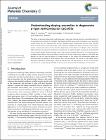| dc.contributor.author | WATSON, GRAEME | en |
| dc.date.accessioned | 2014-12-17T15:14:34Z | |
| dc.date.available | 2014-12-17T15:14:34Z | |
| dc.date.issued | 2014 | en |
| dc.date.submitted | 2014 | en |
| dc.identifier.citation | Scanlon,David O. D.O., Buckeridge,John J., Callow,C. Richard A. C.R.A., Watson,Graeme W. G.W., Understanding doping anomalies in degenerate p-type semiconductor LaCuOSe, Journal of Materials Chemistry C, 2, 17, 2014, 3429-3438 | en |
| dc.identifier.issn | 20507534 | en |
| dc.identifier.other | Y | en |
| dc.identifier.uri | http://hdl.handle.net/2262/72589 | |
| dc.description | PUBLISHED | en |
| dc.description.abstract | The failure to develop a degenerate, wide band gap, p-type oxide material has been a stumbling block for
the optoelectronics industry for decades. Mg-doped LaCuOSe has recently emerged as a very promising
p-type anode layer for optoelectronic devices, displaying high conductivities and low hole injection
barriers. Despite these promising results, many questions regarding the defect chemistry of this system
remain unanswered, namely (i) why does this
degenerate
semiconductor not display a Moss
–
Burnstein
shift?, (ii) what is the origin of conductivity in doped and un-doped samples?, and (iii) why is Mg reported
to be the best dopant, despite the large cation size mismatch between Mg and La? In this article we use
screened hybrid density functional theory to study both intrinsic and extrinsic defects in LaCuOSe, and
identify for the
fi
rst time the source of charge carriers in this system. We successfully explain why
LaCuOSe does not exhibit a Moss
–
Burstein shift, and we identify the source of the subgap optical
absorption reported in experiments. Lastly we demonstrate that Mg doping
is not
the most e
ffi
cient
mechanism for p-type doping LaCuOSe, and propose an experimental reinvestigation of this system | en |
| dc.description.sponsorship | This work in TCD was supported by SFI through the PI pro-
gramme (PI Grant numbers 06/IN.1/I92 and 06/IN.1/I92/EC07).
Calculations in TCD were performed on the Lonsdale and
Kelvin clusters as maintained by TCHPC, and the Stokes and
Fionn clusters as maintained by ICHEC. The UCL/Diamond
work presented here made use of the UCL Legion HPC Facility,
the IRIDIS cluster provided by the EPSRC funded Centre for
Innovation (EP/K000144/1 and EP/K000136/1), and the HECToR
and ARCHER supercomputers through membership of the UK's
HPC Materials Chemistry Consortium, which is funded by
EPSRC grant EP/L000202. | en |
| dc.format.extent | 3429-3438 | en |
| dc.language.iso | en | en |
| dc.relation.ispartofseries | Journal of Materials Chemistry C | en |
| dc.relation.ispartofseries | 2 | en |
| dc.relation.ispartofseries | 17 | en |
| dc.rights | Y | en |
| dc.subject | Mg doping | en |
| dc.subject.lcsh | Mg doping | en |
| dc.title | Understanding doping anomalies in degenerate p-type semiconductor LaCuOSe | en |
| dc.type | Journal Article | en |
| dc.contributor.sponsor | Science Foundation Ireland (SFI) | en |
| dc.contributor.sponsor | Science Foundation Ireland (SFI) | en |
| dc.type.supercollection | scholarly_publications | en |
| dc.type.supercollection | refereed_publications | en |
| dc.identifier.peoplefinderurl | http://people.tcd.ie/watsong | en |
| dc.identifier.rssinternalid | 98432 | en |
| dc.identifier.doi | http://dx.doi.org/10.1039/c4tc00096j | en |
| dc.rights.ecaccessrights | openAccess | |
| dc.contributor.sponsorGrantNumber | 6/IN.1/I92 | en |
| dc.contributor.sponsorGrantNumber | 06/IN.1/I92/EC07 | en |




